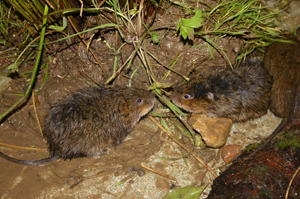 As national figures show a 22 per cent decline in water vole numbers, a new population has been found on the River Winniford in Dorset by the British Association for Shooting and Conservation (BASC). The population was found as part of a landscape-scale water vole project which covers South Somerset and West Dorset and is funded by the SITA Trust.
As national figures show a 22 per cent decline in water vole numbers, a new population has been found on the River Winniford in Dorset by the British Association for Shooting and Conservation (BASC). The population was found as part of a landscape-scale water vole project which covers South Somerset and West Dorset and is funded by the SITA Trust.
The project has identified the location of water voles across six river systems and is one of several led by BASC under its Green Shoots programme. The water voles will be protected from predation through control of the American mink and the creation of suitable habitat which will allow the water voles to expand their range and population. Since 2002 BASC has worked with the Environment Agency (EA), Natural England and other conservation organisations to control mink and improve habitats on the Somerset Levels.
EA funding has enabled work to be expanded onto the River Tone, west of Taunton, and onto the River Axe in cooperation with East Devon District Council. BASC is also leading water vole projects with Natural Resources Wales on the Llyn peninsula and the Menai Straits in North Wales to protect populations both on the mainland and Anglesey.
Robin Marshall-Ball, BASC’s Green Shoots project officer in the South West said: “We have been delighted to find new populations of water voles on the six rivers in our project area. This is the first time water voles have been found on the River Winniford. We will use the survey information to target our work on habitats to link water vole populations together.”
Ian Danby, BASC head of biodiversity projects said “Working with people who shoot is essential for taking action at the landscape scale. Shooting operates over two thirds of the UK’s rural land. People who shoot care about their environment and volunteer their time and effort to help species of conservation importance. Research shows that shooters put in almost three million work days on conservation each year.”